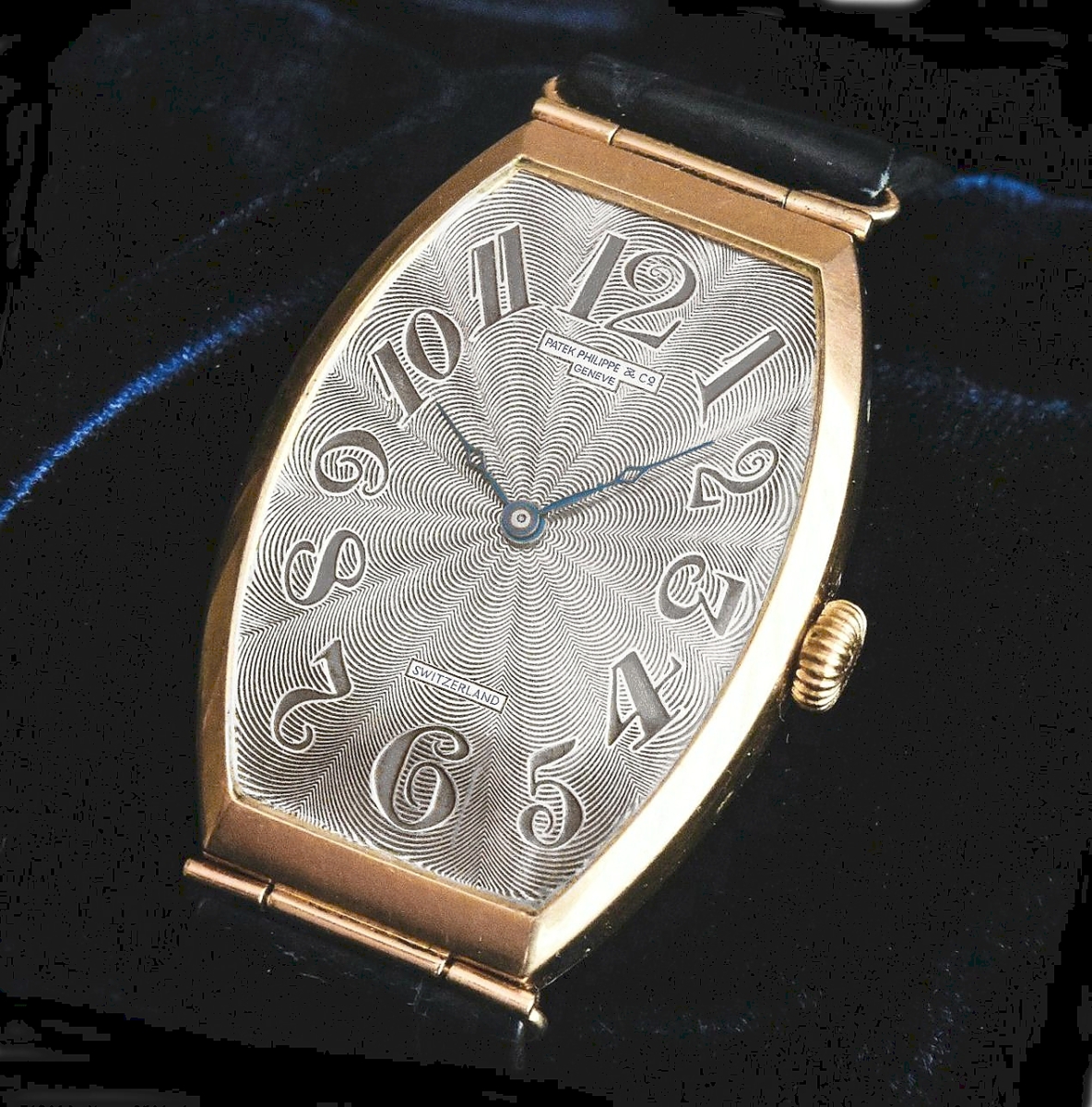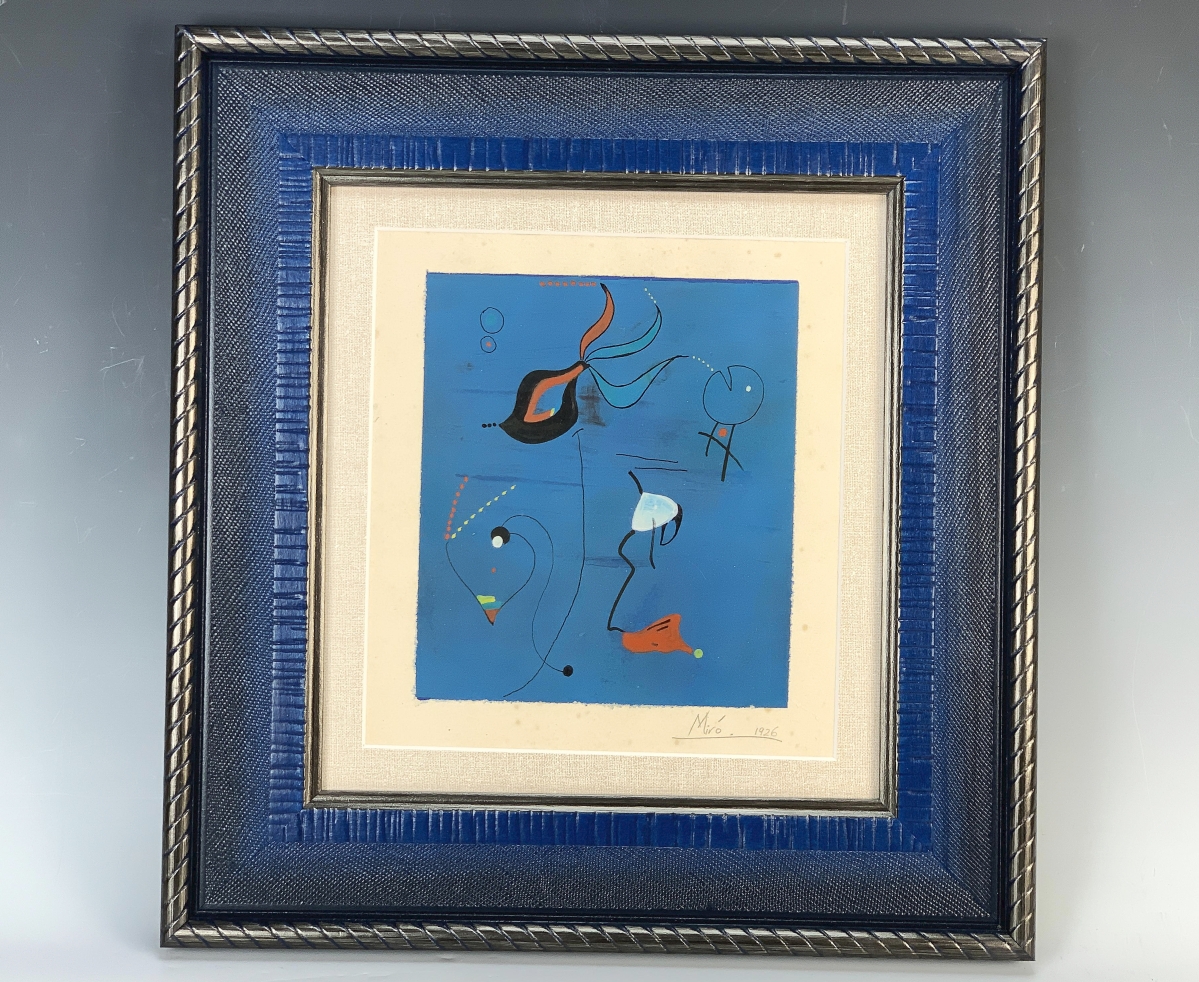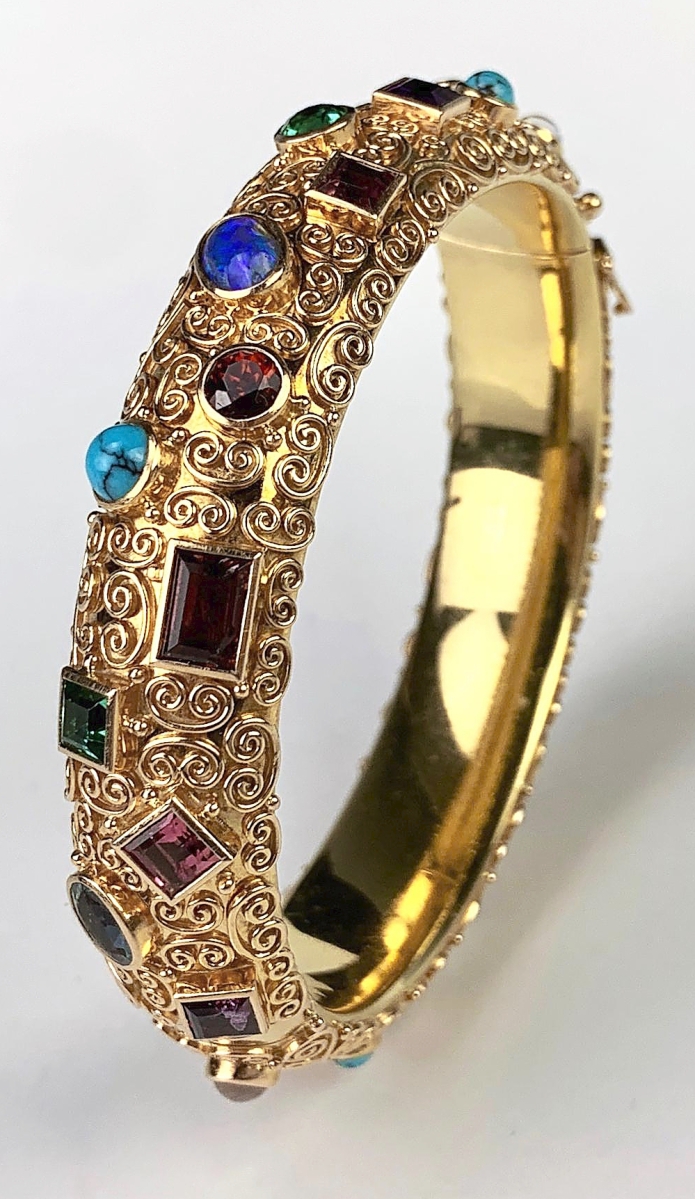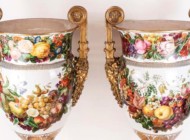
One of 10 in existence, this Patek Philippe Tonneau watch in pure silver and 18K yellow gold was the top selling lot at $18,450.
Review by Z.G. Burnett, Photos Courtesy of Treasureseeker Auctions
PASADENA, CALIF. – Treasureseeker Auctions’ New Year’s Antiques & Decorative Arts sale was a gallery of high-society living in the early Twentieth Century. “The sale was very successful,” said Rick Kaplan. The auction offered more than 300 lots of decorative art, furniture, fine art, collectibles and jewelry, with some categories that performed more strongly than others, totaling approximately $180,000.
Foremost in the auction results was an extremely rare, oversized Patek Philippe watch with Gondolo movement, mounted in 18K yellow gold with a factory original silver hand-guilloche Tonneau shaped dial decorated with large, “exploding” numerals. The watch showed a hinged case and swing wire lugs and retained its original factory hands and crown. Its band was 18K gold and signed “PPC” on its buckle. Only ten of these watches were made circa 1930, and ticked to $18,450.
Out of six lots sold from French painter Louis Icart (1888-1950), one painting and a signed etching rose to the upper ranks of this auction. Second in the sale overall was “Place de la Concorde,” a pastel-toned confection of two fully dressed women, rare in Icart’s oeuvre, strolling the Parisian square in what appears to be late afternoon. The scene sold for $10,455. More in keeping with the artist’s sultry style was “Leda and the Swan,” showing a glowing nude against the embrace of Zeus in the guise of a black swan, that achieved $5,535. Three other Icart etchings also did well; “Pink Slippers” at $1,792, “Behind the Fan” for $492 and a rare image of a multiracial dancing couple for $640. A paperback edition numbered 468/500 of L’Ingenue Libertine by Colette Willy, best known by the mononym Colette (French, 1873-1954), was the first book illustrated by Icart and achieved $1,722.
One of the auction’s gems was a 1926 tempera on paper painting by Joan Miró (Spanish, 1893-1983) that bid to $4,613. The dreamlike image was part of the artist’s “automatic paintings” that were illustrated semi-abstract objects, and shows a surrealist departure from his early figurative works. Miró’s process of automatism referred to creating art without conscious thought, which often resulted in the repetition of symbols such as eyes and birds.

Untitled tempera on paper “automatic” painting by Joan Miró, 1926, 7¾ by 6¾ inches, bid to $4,613.
Bracelets were a popular subcategory in the jewelry section, with four vintage pieces vying for space among the decorative arts lots. The best selling of these was an 18K yellow gold and enamel bracelet with Italian marks, which matched the Miró painting at $4,613. Next was a bangle, also 18K gold, mounted with 28 semiprecious stones and exhibiting unknown marks that closed at $4,305; a Gubelin 18K white gold and diamond link bracelet also went at this price. Another 18K gold bracelet with Italian marks was mounted with lapis beads and sold for $3,998.
Three Art Deco sculptures by Romanian artist Demétre Haralamb Chiparus (1886-1947) were offered in the auction. Chiparus is best known for his chryselephantine figures of dancers and is considered one of the most important sculptors of the Art Deco movement. “Innocence,” a bronze gilt patinated tabletop effigy of a young girl mounted on a pink marble base, was the highest earning sculpture of the sale at $4,305. Examples of this motif appear in Chiparus’ work beginning around 1930; variations in the material include ivory, marble and varying shapes and styles of bases. The second Chiparus bronze, “Accident de Chasse,” shows a youth bandaging an injured dog’s paw and finished at $2,768. The third work from the artist was a terracotta figure of a woman and her children in very good condition that bid to $768.
The auction also offered art glass from the studio of Clément Massier (French, 1844-1911), known for his iridescent metallic glaze for which he was awarded a gold medal at the 1900 Exposition Universelle in Paris. The majority of these sold well, but the best was an extremely rare bowl with eight ring handles, decorated with berries, that achieved $4,305. The second highest Massier piece was a squat bowl, molded with a woman swimming in waves, that sold for $4,160. Both of these were signed and marked for Massier’s factory in Golfe-Juan Vallauris on the Côte d’Azur.
Pablo Picasso (1881-1973) made an appearance in the top lots with an “Oiseau du Soleil” earthenware bowl which was produced from his Madoura pottery studio, also in Vallauris, in an edition of 500. The white-glazed bowl was decorated with, as the name suggests, a bird perched under the sun. This model is listed as #174 in A. Ramie’s 1988 catalog of Picasso’s ceramic works that were made in Madoura, and bid to $3,840.

Mounted with semiprecious stones and dated circa 1975, this 18K bangle fetched $4,305.
Quite a few Art Deco lamps were listed in the sale, and the top-selling lot was somewhat of a mystery. An unsigned “Flowers” lamp, chiseled with intricately detailed bronze blooms on the shade and base was attributed to Armand-Albert Rateau (French, 1882-1938). However, the catalog also mentions that the lamp could be from Tiffany & Co. Either way, it was in good working condition and lit up at $4,380.
One top lot with certain Tiffany attribution was a very rare, possibly unique sterling silver vinaigrette or perfume bottle. Dated 1890, the ribbed baluster body was detached from the florally decorated neck and the dabber on top. Each piece showed Tiffany marks with a monogram on the body, and the “museum worthy” lamp sold for $3,383.
Not solely sourced from France, a German example of Art Nouveau décor also ranked highly in the sale; an inkstand showing a bronze mermaid and a seemingly mustachioed octopus overlooking a pool of water. Combining form with function, the mermaid adorns the tray and pen rest, and the octopus’s head hinges open to reveal an inkwell. This inkstand was made in the prolific Geschutzt foundry and shows this maker’s mark on the bottom surface. Now more of a sculptural piece than an essential desk accessory, the inkstand achieved $3,520.
Prices are quoted with buyer’s premium as reported by the auction house. Treasureseeker Auctions’ next sale will be on February 26. For more information, www.treasureseekerauction.com or 626-529-5775.




















